At just 15 years old, Kristoffer Klaesson signed his first professional contract with the famous Norwegian club Vålerenga. Fast forward more than five years, the now-20-year-old could well be on his way to Elland Road with Leeds United.
According to reports in Norway, the Peacocks have made official contact with Vålerenga and are preparing an offer for the goalkeeper that Leeds’ Director of Football Victor Orta has tracked for some time.
Klaesson has been Vålerenga’s first-choice goalkeeper since the age of 18 and this season is no different as the Norwegian giants sit in third place in the table as things stand. The young keeper has also made 38 appearances for Norway since U15s level, although he is yet to make his first-team debut with the international team.
Klaesson has been extremely impressive in the Eliteserien for Vålerenga since becoming the club’s first-choice keeper, particularly under head coach Dag-Eilev Fagermo.
This article will be a tactical analysis of Klaesson in the form of a scout report. It will be an analysis of the goalkeeper’s strengths and weaknesses as well as how he could potentially fit into the tactics of Marcelo Bielsa’s Leeds.
Disclaimer: the graphs were completed for this scout report prior to Vålerenga’s defeat to Haugesund on July 18 and so the stats may have changed slightly since.
Player profile, weaknesses, and an interview with Gjermund Østby
The left-footed Norwegian stands at 6ft 2 (189cm) and weighs 167lbs (76kg). Klaesson has quite a lean frame for a goalkeeper although he is certainly not weak. In 1v1 situations, he uses his body really well to spread and make the goal look big against opposition players, which has contributed to his 68.75 save percentage. This is something that will be analysed in more detail later.
For this article, Total Football Analysis contacted Vålerenga’s goalkeeping coach Gjermund Østby for an interview on Klaesson, a player that the coach has worked very closely with since he made the step-up to the first-team.
The Norwegian coach gave some very insightful information about Klaesson’s development, strengths, weaknesses, and potential.
When asked what Klaesson’s three great strengths are, Østby replied, “His biggest strengths are shot [stopping], his reach, and 1 against 1.” These will also be analysed in further detail later in this piece when we analyse his saving technique in 1v1 situations.
Østby then commented on the goalkeeper’s mentality, an area of football that cannot be seen from the perspective of a scout or an analyst. The coach said, “I am very impressed [with] his mentality.
“To play for a club like Vålerenga in Norway means a lot of pressure. He had some bad games last year, but he came back in a brilliant way in the last part of the season.
“He has a very good attitude in terms of being a professional player and he is very willing to learn and improve.
“[Klaesson] has improved a lot the last 12 months in terms of the tactical part of the game, on crosses and he is more stable in his performances.”
Østby was asked by Total Football Analysis about the goalkeeper’s weaknesses regarding his passing range too. So far this season, Klaesson has a passing accuracy of just 76.86 percent, the fifth-lowest in the Eliteserien out of all goalkeepers who have played more than five games so far. The 20-year-old is averaging 18.91 passes per 90 too.
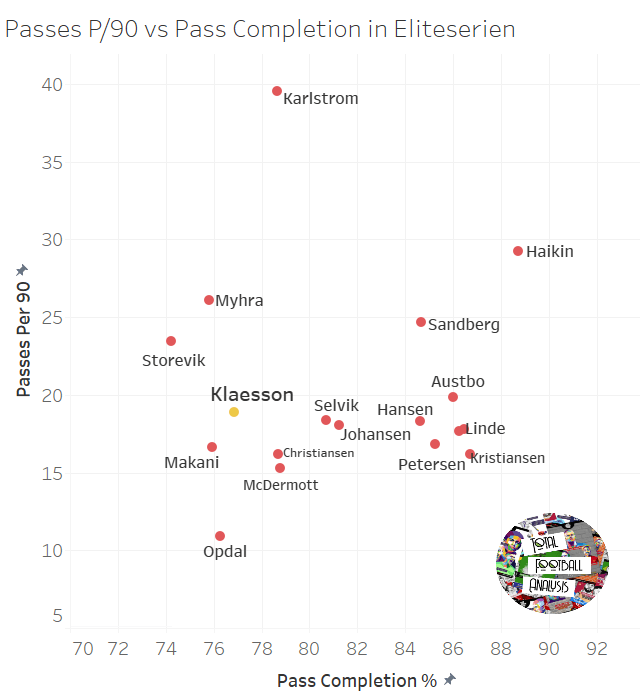
If the player does move to Leeds United, his passing needs serious improvement. As can be seen from the graph above, even with the small volume of passes he makes per 90, Klaesson is completing just two-thirds of these.
What is worse is his long ball completion rate, another very important tool for a goalkeeper.
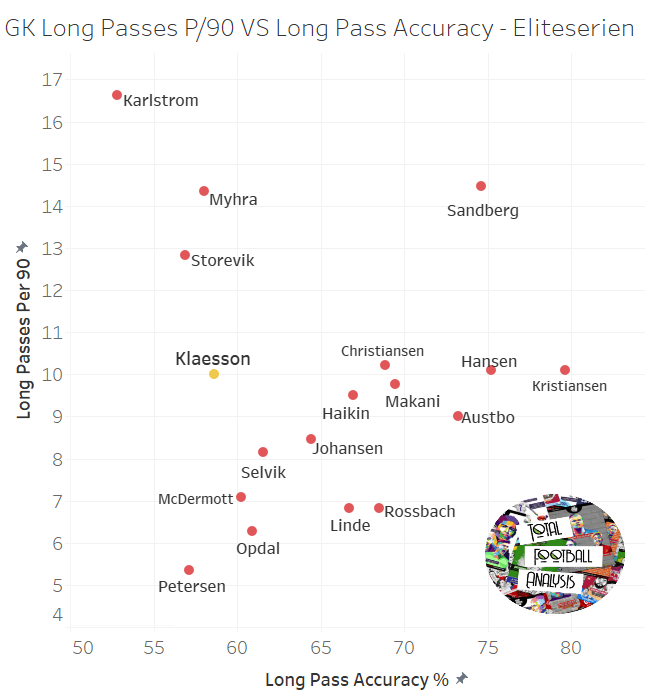
Klaesson is high up on the graph for the number of attempted long balls per 90 but has the fifth-lowest completion rate with an accuracy of just 58.59 percent.
“He has to improve his accuracy on the long balls. There is no one in this league who kicks it longer, but it’s a little bit unstable,” said Østby when questioned on the player’s poor passing range.
Bielsa would certainly have his work cut out for him should a transfer occur where Klaesson moves to Leeds. Although the Argentine coach does have a tendency to improve almost every player he works with so perhaps Klaesson’s numbers will massively improve if a deal goes ahead.
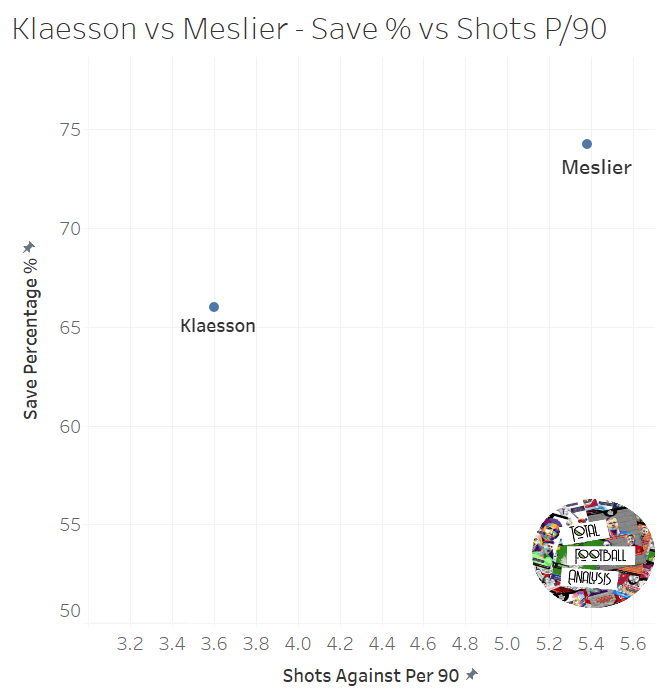
Klaesson would be competing with Ilian Meslier should he move to Leeds this summer. The two players are just nine months apart in their ages, however, as the latter’s metrics show, he is far more advanced at a much higher level so Klaesson will need to greatly improve to compete for a starting spot at Elland Road.
The graphic above measures how many shots are taken against the pair per 90 as well as their save percentage. Meslier’s stats are taken from the 2020/21 Premier League season whilst Klaesson’s stats are from the ongoing 2021 Eliteserien campaign.
As one can see, Meslier faced far more shots per 90 than Klaesson has this season in a much more advanced league. However, the Frenchman has a far superior save percentage too with 74.26 percent compared to Klaesson’s 66 percent.
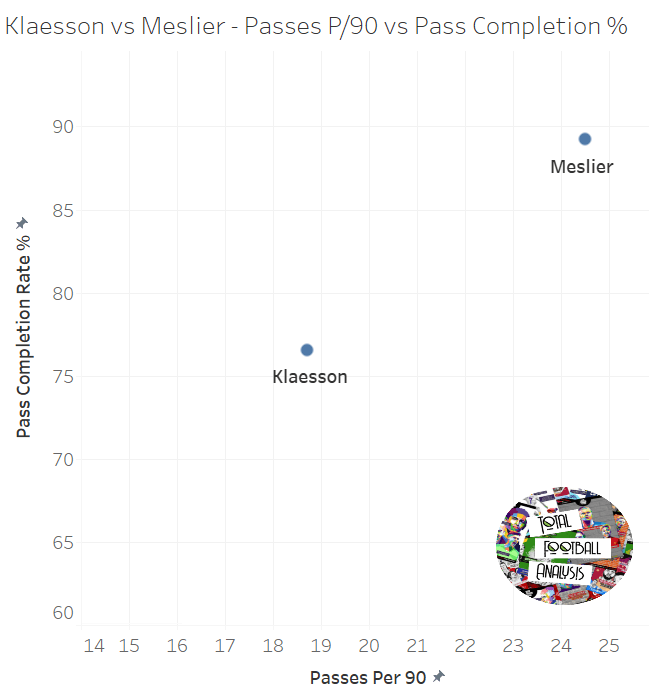
Again, Meslier has far more impressive and superior passing stats compared to Klaesson. The French youth international is averaging 24.51 passes per 90 with an accuracy of 89.24 percent. As already stated earlier, Klaesson attempts just 18.71 passes per game with an inferior to Meslier of 76.54 percent.
One area that Klaesson does beat Meslier is his short and medium passing accuracy. Despite attempting fewer short/medium passes – 8.63 to Meslier’s 18.12 – the Norwegian has a better passing completion from this range with 98.33 percent to the Frenchman’s 97.35 percent.
It is mainly his long passing that needs work, so perhaps Klaesson is not as far behind technically as once thought. Going off Østby’s comments surrounding his willingness to learn and improve, Klaesson will not be a player content with sitting on the bench week-in and week-out. Should the deal go ahead, Meslier may be forced to look over his shoulder quite a lot with the added competition.
Quick reflexes, speed, and excellent shot-stopping
Saying that a goalkeeper is an excellent shot-stopper is quite a cliché and perhaps should be a bit of a prerequisite for a player whose job it is to stop shots from hitting the back of the net. However, Klaesson is a very efficient shot-stopper and his incredible reflexes are a reason for this.
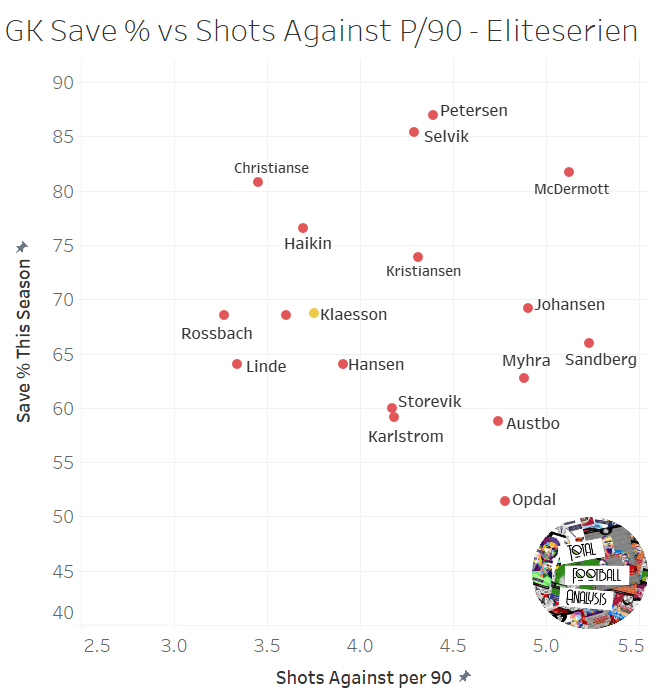
The graph above looks at how Klaesson fairs against other goalkeepers in the Eliteserien this season who have played more than five games in terms of their save percentage and shots against per 90.
Klaesson has faced the sixth-least amount of shots in the Eliteserien per 90 and has a 68.75 save percentage of these shots. Essentially, the keeper saves two out of every three shots which is not too bad, although it is quite average compared to the other goalkeepers in the league.
There is still quite a lot of room for improvement in terms of his numbers, but considering he is only 20, it is quite promising.
The Norwegian is rather quick off the mark and is able to bounce to his feet rapidly to save rebounded shots, one of his best attributes. This has led to some miraculous saves from Klaesson over the course of the past season.
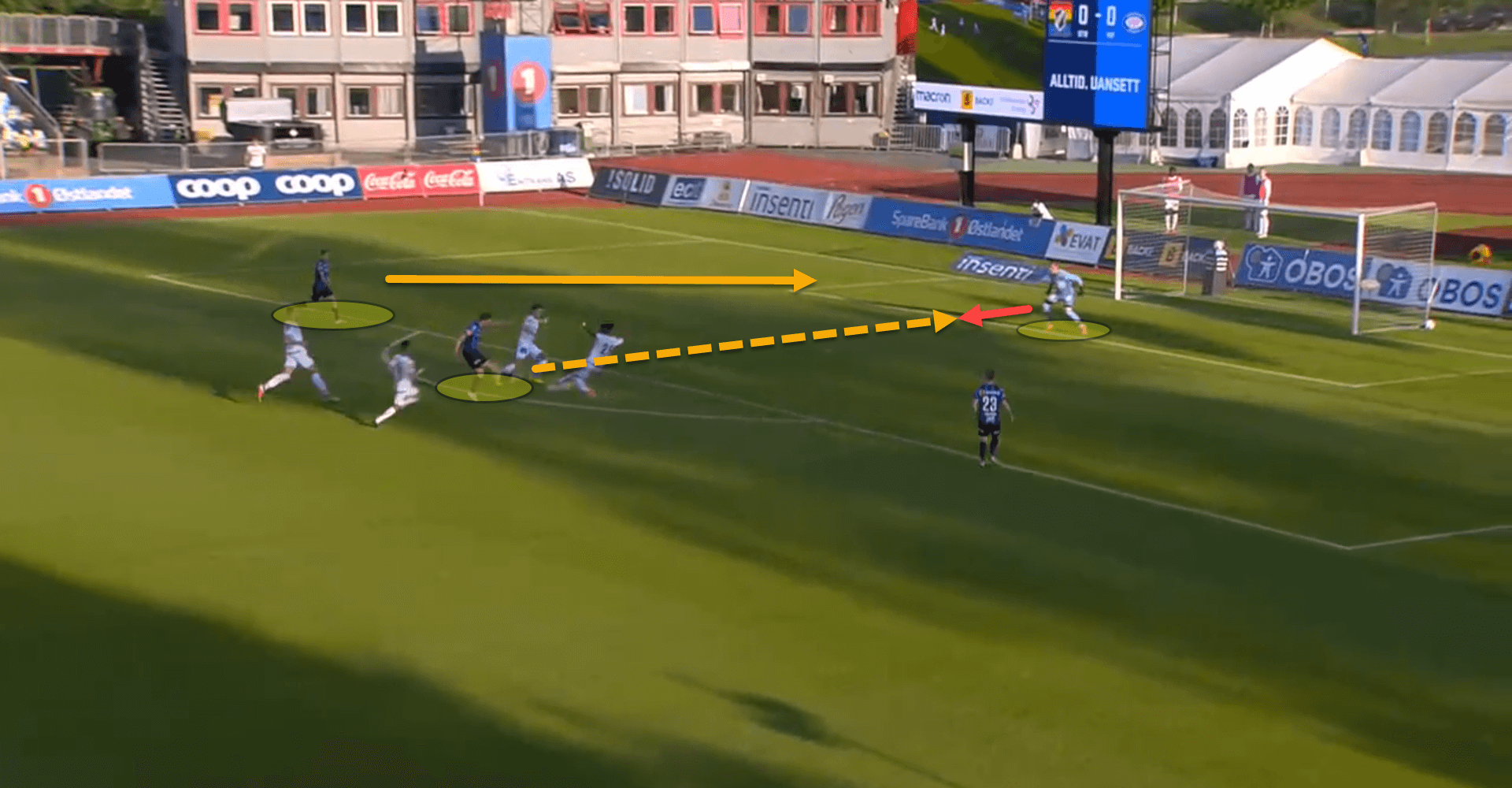
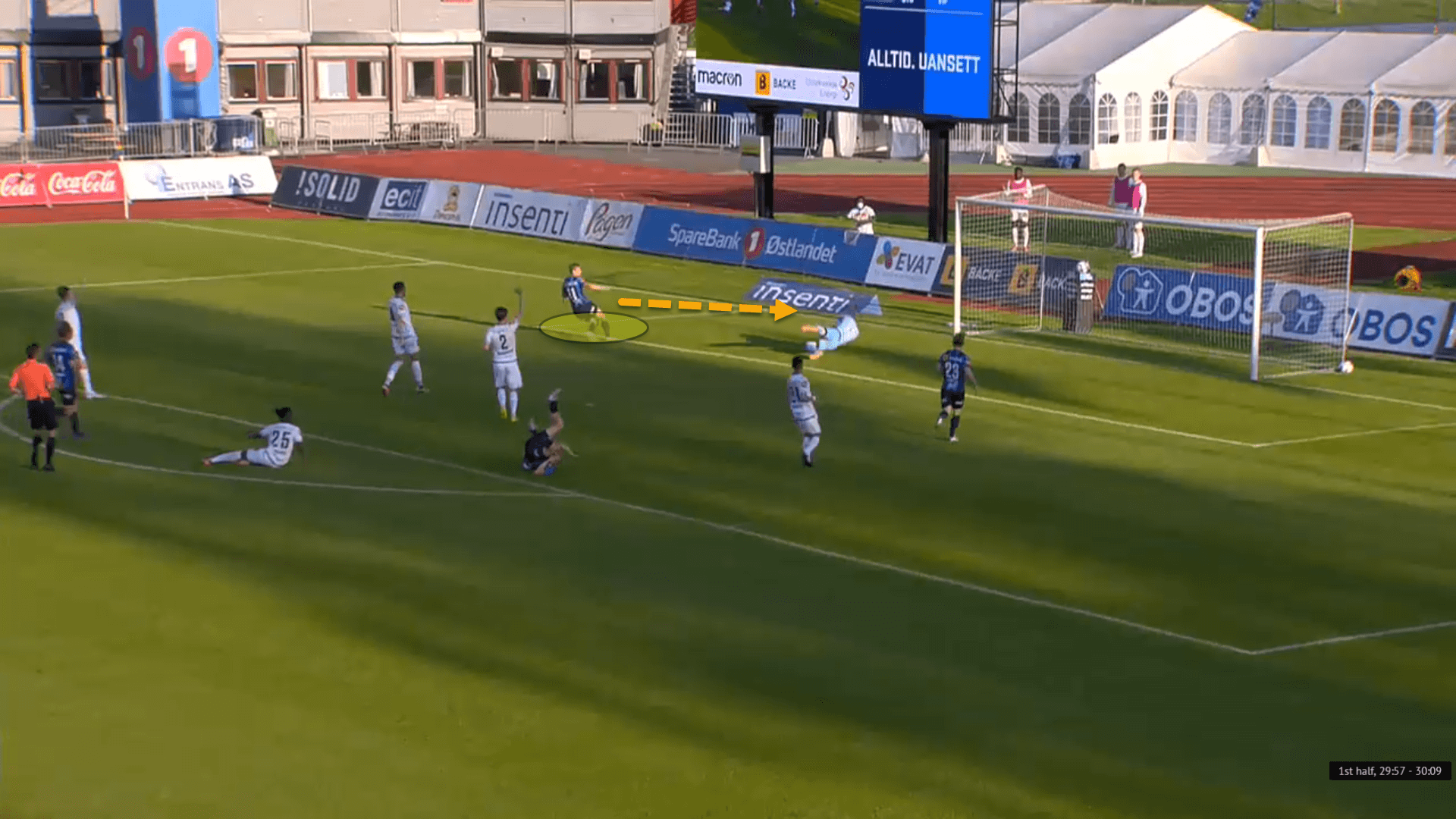
Here is an example of Klaesson’s superb reflexes which helped him to pull off a wonderful double save. In the first image, he has stayed deep and has positioned himself well to cover both sides of the goal depending on the direction of the shot.
The opposition player shoots low and hard down to Klaesson’s right which is palmed away but one of the other forwards has come in to convert the rebound. Within a second after the original save, the Norwegian goalkeeper has got back to his feet to stop the second strike.
A fair criticism of the keeper would be that sometimes the area that he palms the ball out can be irrational. Typically, when a goalkeeper makes a save, especially from distance, if the shot is struck with a difficult pace to catch, the keeper will palm it out to a specific location, generally where there is no opposition player to convert the rebound.
Klaesson’s focus is solely just on preventing the goals and there is little thought to wear he palms the ball, which can often leave him susceptible to having to make incredible saves from the rebound.
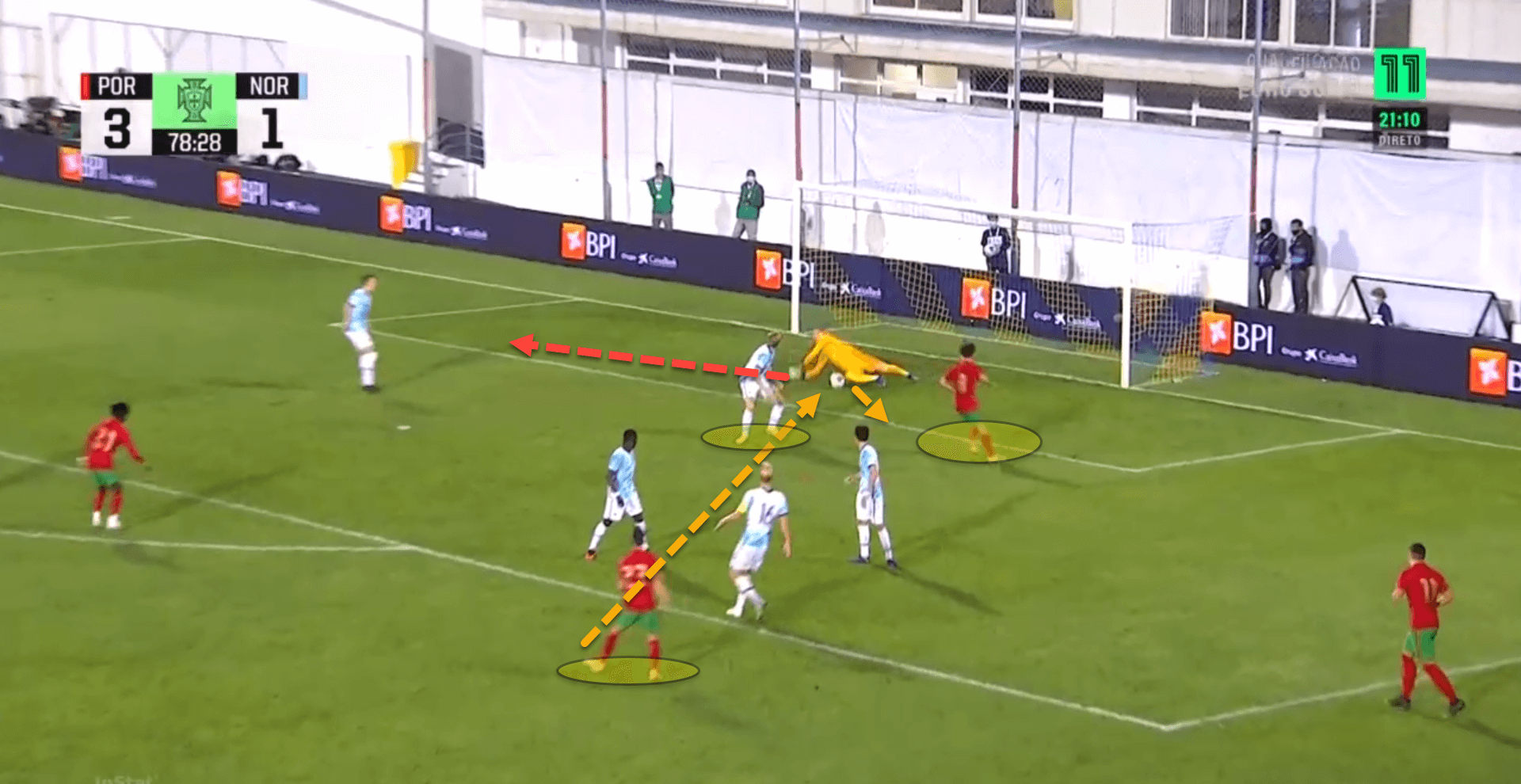
Here is another example of this rather sporadic shot-stopping from Klaesson. Portugal took a shot from outside the box which was saved by the Norwegian keeper. Instead of palming it out to his right – where he is supported by a defender who can clear the ball – the ball ends up landing in front of him where another Portuguese player stood which almost cost them a fourth goal.
Positioning and 1v1 technique
Klaesson’s positioning is one of his better attributes. The goalkeeper also positions himself well in the goal to cover all angles, allowing him to have the best possible chance of saving a shot.
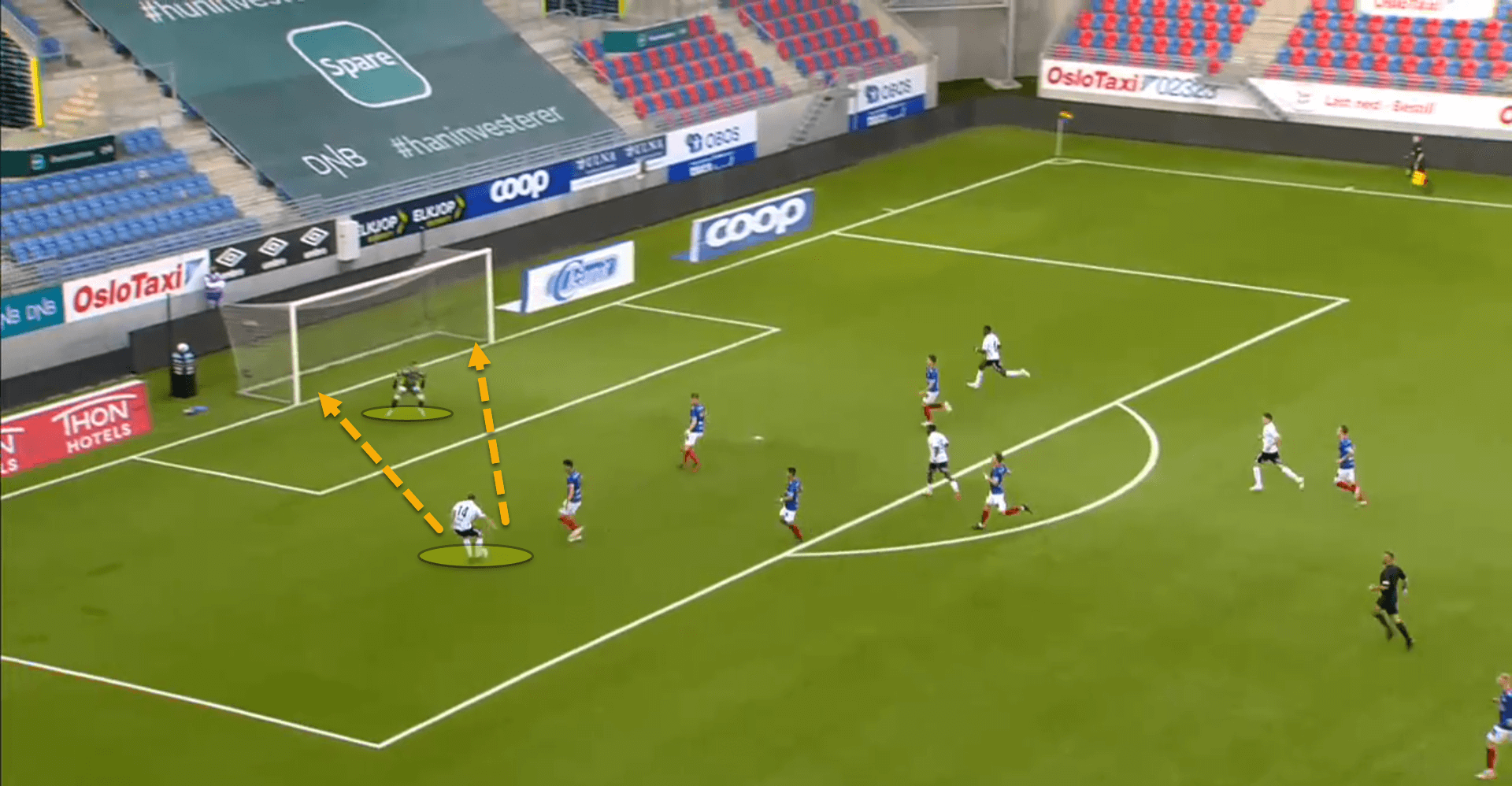
Here, rather than engaging with the ball-carrier who is about to shoot, Klaesson stays deep in his goal but not on the line, closing down the angle that the player has to shoot into. As can be seen in the image, the keeper makes the goal ‘look big’ as the cliché goes.
He has ensured that he has covered both the far-post and the near-post while keeping a solid stance to react to the movement of the ball.
Another example of this can be seen in the following image:
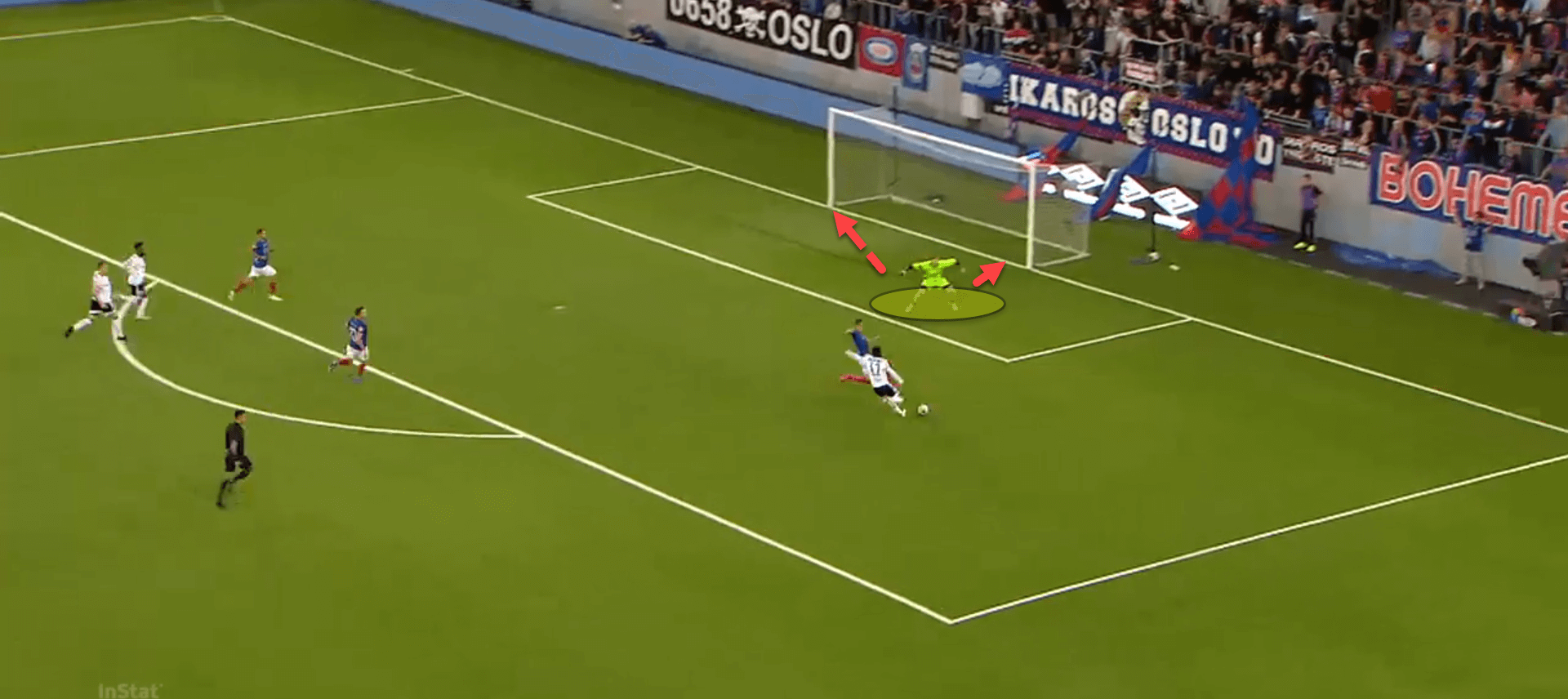
Again, Klaesson has come a few yards off his goal-line to close down the angle of the strike which makes it extremely difficult for the shooter to find a gap to try and put the ball into.
When in a 1v1 situation, Klaesson tends to use a plethora of different goalkeeping techniques that he is comfortable with. From wider angles, the goalkeeper stays on his line and looks to stay deep at his near post and block a shot as opposed to engaging with the player.
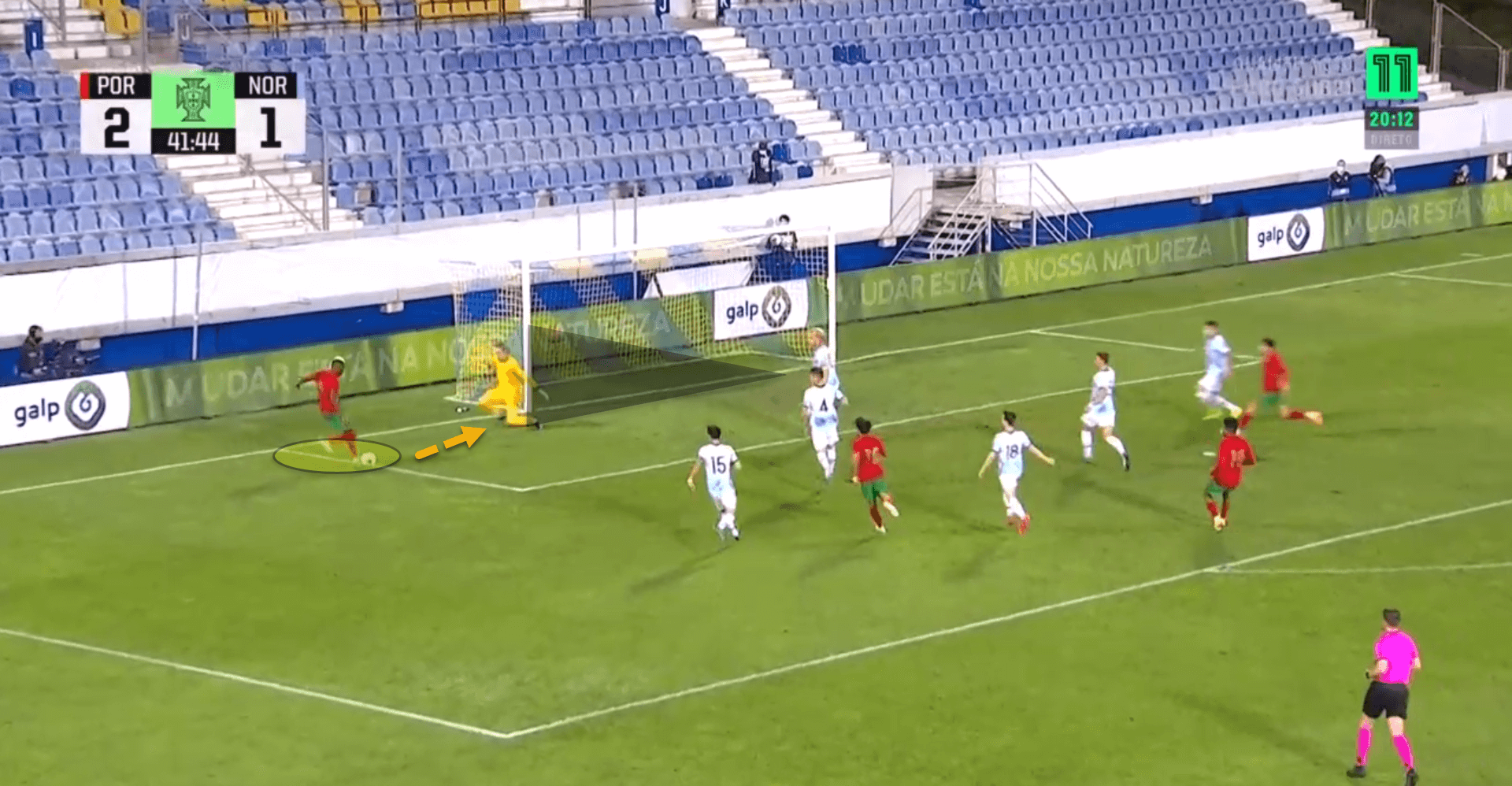
David de Gea uses this technique very well at Manchester United. It is essentially a closed-body type stance but makes the angle for a shot extremely difficult and stops the ball from going through the keeper’s legs as can be seen above.
From a more central position in a 1v1 situation, Klaesson uses an engage and spread technique. Essentially, the Norwegian will close the player down and spread himself. This is necessary – and is used by most top goalkeepers – because the keeper needs to make himself look big since the shooter has more space to put the ball naturally because of the angle.
This technique involves engaging with the shooter by coming off your line while keeping your legs and arms wide.
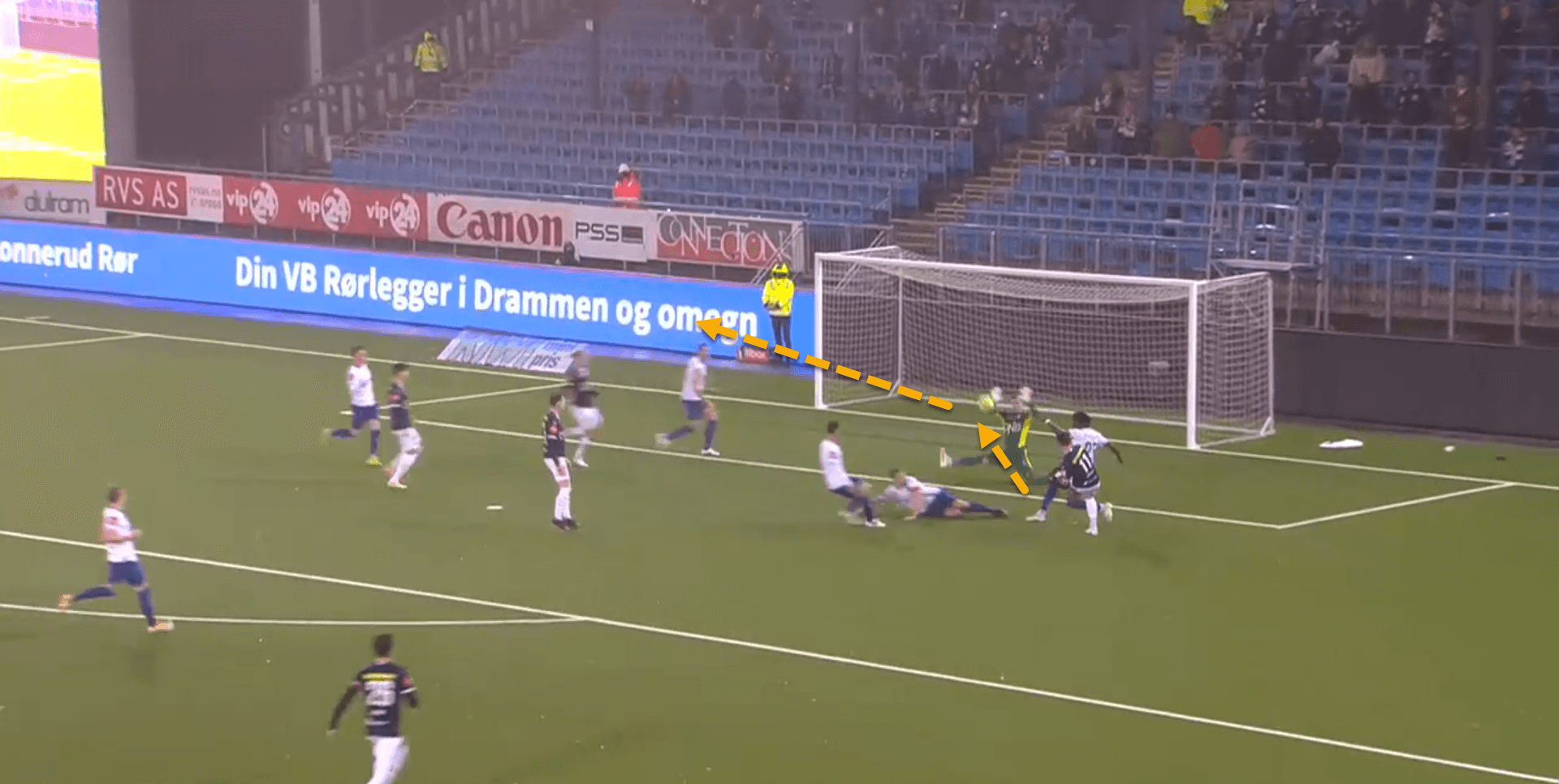
In this example, Klaesson makes a fabulous point-blank-range stop by using this technique. The problem with this of course is that the goalkeeper is susceptible to having the ball put through their legs but there is no technique that will definitely stop a goal, just limit the chances of one being scored.
The 20-year-old has a great understanding of what techniques are best to use in certain situations which is a great attribute for a goalkeeper.
Crosses and dead-balls
The final area of Klaesson’s game that will be analysed during this scout report is his ability to deal with aerial balls, one of the Vålerenga goalkeeper’s worst attributes but one of his rapidly improving attributes according to Østby.
This season, so far in the Eliteserien, Klaesson has averaged 1.09 exits per 90, the fifth-lowest in the league from all of the goalkeepers who have played at least five matches.
From set-pieces, Klaesson tends not to come off his line. He is not comfortable being commanding in his box and coming out to punch the ball as he is not the most physically imposing goalkeeper. This is very similar to David de Gea when he first arrived in England following his move from Atletico Madrid.
Staying on his line during set-pieces gives him more time to react to a header or a shot towards goal. It also ensures that he is back on his line for the second phase of a set-piece where goalkeepers can sometimes be caught out if they have come out to collect a ball and fail.
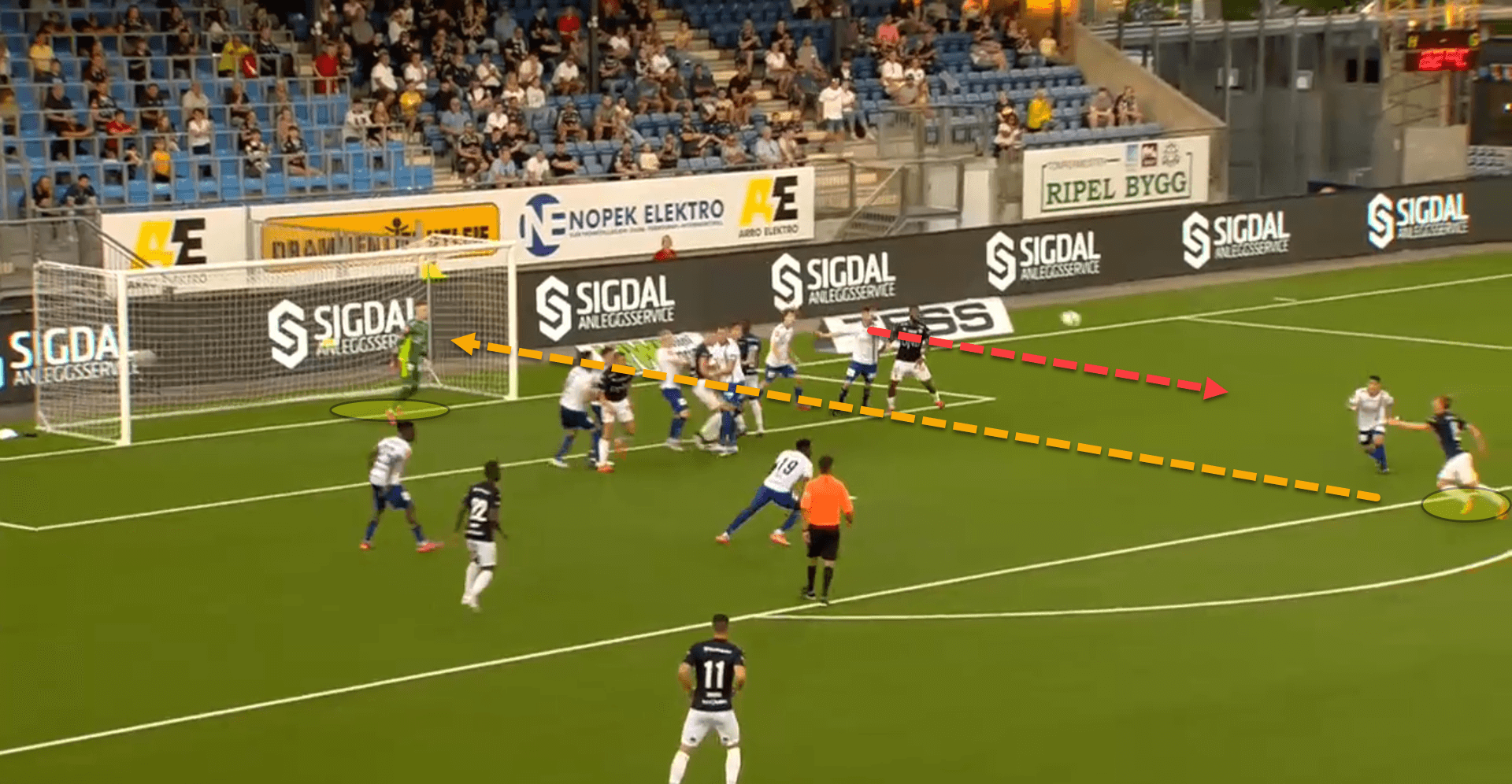
By Klaesson staying on his line though, it can prove disastrous at times. There is more of the goal to aim at for a player heading or shooting from a cross since Klaesson is remaining deep. Particularly if the ball is put into the corner, it is far too difficult for him to get across in time.
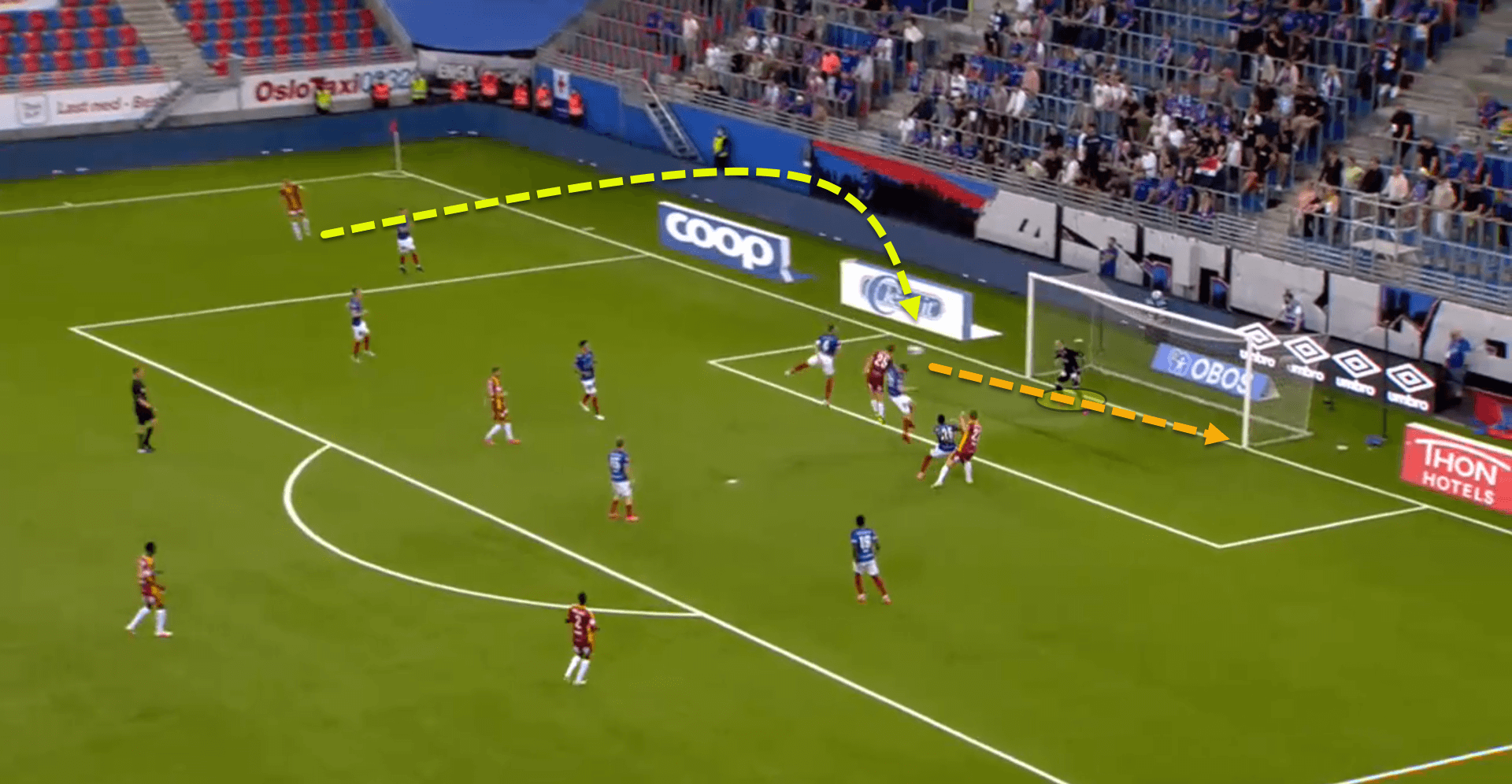
Instead of coming out to meet this ball with a fist, as it was rather close to him, Klaesson stayed deep to react to the header. However, the ball was headed into the corner and could not get across in time due to the nature of his positioning. The ball hit the post and was eventually poked home in the end.
Teams have begun taking advantage of Klaesson’s lack of physicality which has proved to be quite detrimental to Vålerenga since he has become the club’s first-choice goalkeeper. By using different corner techniques and piling men around Klaesson, the 20-year-old has a tendency to flap and this can lead to major errors.
In a recent game against Haugesund, a 3-1 defeat for Vålerenga, the eventual winners planted a man in front of Klaesson during the corner to challenge him for the cross. The keeper could not deal with the ball and the added physical duel and ended up falling into the goal with the ball, a comically disastrous goal to concede.
In the Premier League this would be a major worry as a lot of Premier League teams would feed off of this lack of physicality and it is certainly an area of his game that needs massive improvement should he move to a bigger and better league.
Conclusion
When asked by Total Football Analysis about Klaesson’s ceiling in terms of his potential, Østby claimed that the sky was the limit for the young Norwegian keeper: “In a year or two I think he can be our next goalkeeper on the national team, and if he comes to a club that is willing to let him play in spite his age, I think he can play for a top European team.”
Given his track record of playing young players, perhaps Leeds United is the ideal club for Klaesson’s development and if Østby’s prediction about his future career is right, the Peacocks will have picked up a bargain.






Comments